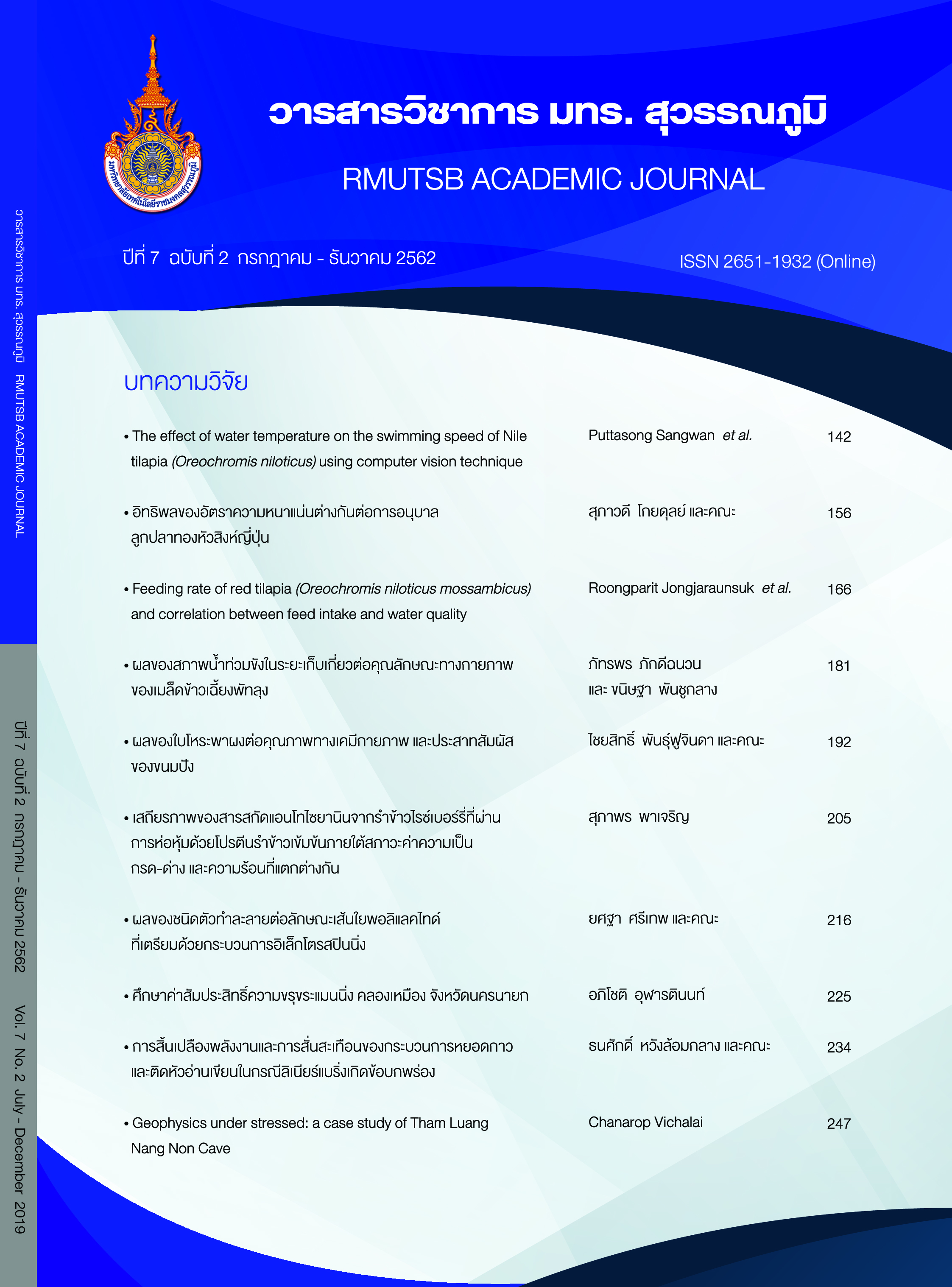Stability of anthocyanin extract from riceberry rice bran encapsulated with rice bran protein concentrate under different pH and heating conditions
Main Article Content
Abstract
The objectives of this research were to study the effect of different pH and heating conditions on the stability of anthocyanin extract from riceberry rice bran (RRBE), RRBE encapsulated with maltodextrin (RRBE with MD) and RRBE encapsulated rice bran protein concentrate (RBPc) plus maltodextrin at a ratio of 80:20 by weight (RRBE with RBPc plus MD). The results showed that pH value significantly affected the anthocyanin stability (p<0.05). Anthocyanin was stable at pH 1 and 4; however, it was unstable at pH 9. At pH 9, the losses of anthocyanin in RRBE with RBPc plus MD and RRBE with RBPc plus MD were 42.58 and 22.57, respectively. Temperature or heating levels also significantly affected the anthocyanin stability (p<0.05). After heating at 70, 80 and 90 °C, the results showed that heating at 90 °C, anthocyanin in HRBE was much less stable than that in HRBE encapsulated with RBPc:MD. In overall, the results indicated that encapsulation of HRBE with RBPc:MD could protect against the loss of anthocyanin in HRBE due to the effect of different pH and heating conditions.
Article Details
Published manuscript are the rights of their original owners and RMUTSB Academic Journal. The manuscript content belongs to the authors' idea, it is not the opinion of the journal's committee and not the responsibility of Rajamangala University of Technology Suvarnabhumi
References
Betz, M., & Kulozik, U. (2011). Whey protein gels for the entrapment of bioactive anthocyanins from bilberry extract. International Dairy Journal, 21(9), 703-710.
Devi, P. S., Saravanakumar, M., & Mohandas, S. (2012). The effects of temperature and pH on stability of anthocyanins from red sorghum (Sorghum bicolor) bran. African Journal of Food Science, 6(24), 567-573.
Esmaeili, M., Rafe, A., Shahidi, S. A., & Hasan-Saraei, A. G. (2016). Functional properties of rice bran protein isolate at different pH levels. J. Cereal Sci. 93(1), 58-63.
Ferreira, C. D., Da Conceição, E. J. L., Machado, B. A. S., Hermes, V. S., De Oliveira Rios, A., Druzian, J. I., & Nunes, I. L. (2016). Physicochemical characterization and oxidative stability of microencapsulated crude palm oil by spray drying. Food and Bioprocess Technology, 9(1), 124-136.
Floegel, A., Kim, D., Chung, S., Koo, S. I., & Chun, O. K. (2011). Comparison of ABTS/DPPH assays to measure antioxidant capacity in popular antioxidant-rich US foods. J. Food Compos. Anal. 24, 1043-1048.
Giusti, M. M., & Jing, P. (2008). Analysis of pigments and colorants. In C. Sosaciu, (Ed.), Food colorants: chemical and functional properties (pp. 479-506). Boca Raton, Fla: CRC Press.
Hou, Z., Qin, P., Zhang, Y., Cui, S., & Ren, G. (2013). Identification of anthocyanins isolated from black rice (Oryza sativa L.) and their degradation kinetics. Food Research International, 50(2), 691-697.
Jiang, T., Mao, Y., Sui, L., Yang, N., Li, S., Zhu, Z., Wang, C. ,Yin, S., He, J., & He, Y. (2019). Degradation of anthocyanins and polymeric color formation during heat treatment of purple sweet potato extract at different pH. Food Chemistry, 274, 460-470.
Kaewka, K., Therakulkait, C., & Cadwallader, K. R. (2009). Effect of preparation conditions on composition and sensory aroma characteristics of acid hydrolyzed rice bran protein concentrate. J. Cereal Sci, 50, 56-60.
Kong, S., & Junsoo, L. (2010). Antioxidants in milling fractions of black rice cultivars. Food Chemistry, 120, 278-281.
Martynenko, A., & Chen, Y. (2016). Degradation kinetics of total anthocyanins and formation of polymeric color in blueberry hydrothermodynamic (HTD) processing. Journal of Food Engineering, 171, 44-51.
Nuzhet, T., & Erdogdu, F. (2006). Effects of pH and temperature of extraction medium on effective diffusion coefficient of anthocyanin pigments of black carrot (Daucus carotavar. L.). Journal of food Engineering, 76, 579-583.
Palakajornsak, Y. (2004). Extraction and stability of anthocyanins from mangosteen peel (Master’s thesis). Silpakorn University, Bangkok.
Rafe, A., & Sadeghian, A. (2017). Stabilization of Tarom and Domesiah cultivars rice bran: Physicochemical, functional and nutritional properties. Journal of Cereal Science, 74, 64-71.
Roobha, J. J., Saravanakumar, M., Aravindhan, K. M., & Devi, P. S. (2011). The effect of light, temperature, pH on stability of anthocyanin pigments in Musa acuminata bract. Res. Plant Biol, 1, 5-12.
Wang, L., Zhao, Y., Zhou, Q., Luo, C. L., Deng, A. P., Zhang, Z. C., & Zhang, J. L. (2017). Characterization and hepatoprotective activity of anthocyanins from purple sweet potato (Ipomoea batatas L. cultivar Eshu No. 8). Journal of Food and Drug Analysis, 25(3), 607-618.
Worsltad, R. E., Durst, R. W., & Lee, J. (2005). Tracking color and pigment changes in anthocyanin products. Trends Food Sci. Technol. 16, 423-428.


